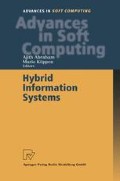Abstract
In this paper we introduce a new version of the machine learning algorithm, FDM2, based on a notion of the fuzzy derivative, which is mainly directed to handling large datasets. The main idea is to describe the influence of the change of one parameter on another. In this algorithm we generate sets of classification rules. We define a coefficient of significance for every single rule. This coefficient describes for a test example a degree of membership of the class predicted by the rule. A new example is classified into a class for which its total degree of membership is maximal. In this way the effect of a single non-informative rule having occurred by chance is decreased due the coefficient of significance. The fuzzy derivative method is mainly used to study systems with qualitative features, but it also can be used for systems with quantitative features. The algorithm is applied to classification problems and comparisons made with other techniques.
Access this chapter
Tax calculation will be finalised at checkout
Purchases are for personal use only
Preview
Unable to display preview. Download preview PDF.
References
Bagirov A. M., Rubinov A. M. and Yearwood J. (2001) A global optimization approach to classification. University of Ballarat, Research Report, 01/4.
Bennett K. P. and Mangasarian O. L. (1992) Robust linear programming discrimination of two linearly inseparable sets. Optimization Methods and Solware, 1, 23–34.
Bradley P. S. and Mangasarian O. L. (1998) Feature selection via concave minimization and support vector machines. Machine Learning Proceedings of the Fifteenth International Conference (ICLML’98), J.Shavlik (ed.), Morgan Kaufmann, San Francisco, California, 82–90.
Buckley J. J., Yunaxia Qu. (1991) Fuzzy complex analysis I: Differentiation. Fuzzy Sets and Systems, 41, 269–284.
Chen C. and Mangasarian O. L. (1995) Hybrid misclassification minimization Mathematical Programming Technical Report, 95–05, University of Wisconsin.
Clark P. and Niblet T. (1989) The CN2 Induction Algorithm. Machine learning, 3, 261283.
Dubois D. and Prade H. (1991) Towards Fuzzy differential calculus. Part 1: Integration of Fuzzy mappings. Fuzzy Sets and Systems, 8 1–17.
Ferraro M. and Foster D. N. (1987) Differentiation of Fuzzy Continuous Mappings on Fuzzy Topological Vector Spaces. Journal of Mathematical Analysis and Applications, 121, 589–60.
Kalbfleish J. (1979) Probability and statistical inference, (Vol. 2 ). New York: Springer-Verlag.
Mamedov M. A. (1994) Fuzzy derivative and dynamic systems. Proc. of the Intern. Conf. On Appl. of Fuzzy systems, ICAFS-94, Tabriz ( Iran ), Oct. 17–19, 122–126.
Mammadov M. A. (2001) Fuzzy derivative and its applications to data classification. University of Ballarat, Research Report, 01 /13.
Mamedov M. A., Rubinov A. M. and Yearwood J. (2001) Sequential separation of sets and its applications to data classification. Proc. of the Post-gr. ADFA Conf. On Computer Science, Canberra ( Aust. ), July, 14, 75–80.
Mangasarian O. L. (1994) Misclassification minimization. Journal of Global Optimization. 5, 309–323.
Michie D., Spiegelhalter D. J. and Taylor C. C. (eds.) (1994) Machine Learning, Neural and Statistical Classification. Ellis Horwood Series in Artifical Intelligence, London.
Murphy P. M. and Aha D. W. (1992) UCI repository of machine learning databases. http://www.ics.edu./ mlearn/MLRepository.html.
Zadeh L. A. (1965) Fuzzy sets. Inform. and Control, 8, 338–353.
Author information
Authors and Affiliations
Editor information
Editors and Affiliations
Rights and permissions
Copyright information
© 2002 Springer-Verlag Berlin Heidelberg
About this paper
Cite this paper
Mamedov, M.A., Yearwood, J. (2002). An Induction Algorithm with Selection Significance Based on a Fuzzy Derivative. In: Abraham, A., Köppen, M. (eds) Hybrid Information Systems. Advances in Soft Computing, vol 14. Physica, Heidelberg. https://doi.org/10.1007/978-3-7908-1782-9_17
Download citation
DOI: https://doi.org/10.1007/978-3-7908-1782-9_17
Publisher Name: Physica, Heidelberg
Print ISBN: 978-3-7908-1480-4
Online ISBN: 978-3-7908-1782-9
eBook Packages: Springer Book Archive

